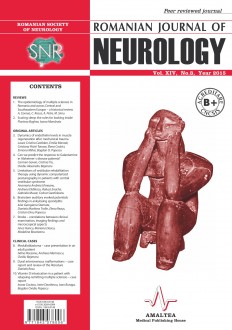SELECT ISSUE

Indexed

| |

|
|
|
| |
|
|
|

|
|
|
|
|
|
| |
|
|
HIGHLIGHTS
National Awards “Science and Research”
NEW! RJN has announced the annually National Award for "Science and Research" for the best scientific articles published throughout the year in the official journal.
Read the Recommendations for the Conduct, Reporting, Editing, and Publication of Scholarly work in Medical Journals.
The published medical research literature is a global public good. Medical journal editors have a social responsibility to promote global health by publishing, whenever possible, research that furthers health worldwide.
LIMITATIONS OF VESTIBULAR REHABILITATION THERAPY USING DYNAMIC COMPUTERIZED POSTUROGRAPHY IN PATIENTS WITH CENTRAL VESTIBULAR SYNDROME
Anamaria Andreia Ulmeanu, Andreea Didilescu, Raluca Enache, Gabriela Musat and Codrut Sarafoleanu
ABSTRACT
Objectives. To evaluate the importance of computerized dynamic posturography in vestibular rehabilitation (VR) of patients with central vestibular syndrome.
Methods. The study included 30 patients with central vestibular syndrome with mean age (± SD) = 72.96 ± 11.97 which benefited from VR on a posturography platform between 2012-2014. All patients were evaluated using sensory integration tests. The parameters studied were: Romberg coefficient, statokinesigram (SKG), maximum amplitude of the degree of deviation in anterior-posterior and medial-lateral planes, SKG and the time interval of the rehabilitation program.
Results. All of the analyzed parameters showed statistically significant results (p <0.05). The anterior-posterior and medio-lateral balance improved significantly at the end of the vestibular rehabilitation program and the parameters decreased to values close to normal.
Conclusions. For patients with central vestibular syndrome, the vestibular rehabilitation improves postural stability and quality of life by reducing the risk of falls.
Keywords: posturography, central vestibular syndrome, vestibular rehabilitation, risk of fall
Full text | PDF
